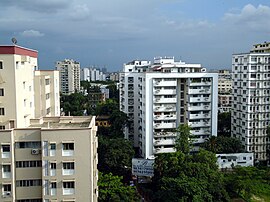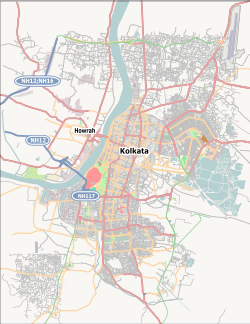This article needs additional citations for verification. (March 2018) |
Ballygunge is a locality of South Kolkata in Kolkata district in the Indian state of West Bengal. It is one of the city's most affluent neighbourhoods.
Ballygunge | |
|---|---|
Neighbourhood in Kolkata (Calcutta) | |
 Ballygunge Circular Road | |
| Coordinates: 22°31′44″N 88°21′43″E / 22.529°N 88.362°E | |
| Country | India |
| State | West Bengal |
| City | Kolkata |
| District | Kolkata |
| Kolkata Suburban Railway | Ballygunge Junction |
| Metro Station | |
| Municipal Corporation | Kolkata Municipal Corporation |
| KMC wards | 65, 68, 69, 85, 86, 90 |
| Population | |
• Total | For population see linked KMC ward pages |
| Time zone | UTC+5:30 (IST) |
| Area code | +91 33 |
| Lok Sabha constituency | Kolkata Dakshin |
| Vidhan Sabha constituency | Ballygunge, Rashbehari |
History
editThe East India Company obtained from the Mughal emperor Farrukhsiyar, in 1717, the right to rent from 38 villages surrounding their settlement. Of these 5 lay across the Hooghly in what is now Howrah district. The remaining 33 villages were on the Calcutta side. After the fall of Siraj-ud-daulah, the last independent Nawab of Bengal, it purchased these villages in 1758 from Mir Jafar, and reorganised them. These villages were known en-bloc as Dihi Panchannagram and Ballygunge was one of them. It was considered to be a suburb beyond the limits of the Maratha Ditch. Beltala was a village in Dihi Mohanpur (later Monoharpukur).[1][2][3]
Ballygunge grew up around a market for sand (bali in Bengali) and had garden-houses of 18th century Europeans. Amongst the prominent residents were George Mandeville, the zamindar/ collector, and Colonel Gilbert Ironside, a friend of Warren Hastings. In 1840, Emily Eden called Ballygunge 'our Eltham or Lewisham'. It also emerged as a citadel of the educated Bengali middle class after the suburban railway opened up the area.[4]
In 1888, Ballygunge and Tollygunge had a combined thana (police station).[4]
Entally, Manicktala, Beliaghata, Ultadanga, Chitpur, Cossipore, parts of Beniapukur, Ballygunge, Watgunge and Ekbalpur, and parts of Garden Reach and Tollygunge were added to Kolkata Municipal Corporation in 1888. Garden Reach was later taken out.[5]
When the Bengal Renaissance started taking roots in 19th century Calcutta, it was initially limited to the predominantly Hindu 'Indian town' stretching north and north-east from the fringes of Burrabazar, with a somewhat later extension south and south-east of the 'European town' to Bhowanipore, and some decades later to Ballygunge, which was then developing as a suburb.[6][7]
In the first half of the 20th century, "in the milieu of relative urban prosperity... Calcutta's rich citizens – those connected with jute, coal, tea, other industries, trade, money-lending and rentier income from urban property – did fabulously well for themselves." Large chunks of Ballygunge, Sunny Park, Rainey Park and Southern Avenue were developed during the 1930s and 1940s. Many of the mansions in Ballygunge, Bhowanipore and Alipore were built by the city's Bengali and new Marwari elite who wanted to move from the "dirtier sections of north Calcutta to the more fashionable areas in the south".[8]
Geography
editLocation
editBallygunge is flanked by Park Circus in the north, Kasba and the Eastern Railway south suburban line in the east, Dhakuria and the Lakes (now called Rabindra Sarobar) in the south, and the localities of Bhowanipore and Lansdowne in the west. It is served by Ballygunge Junction railway station.
Police districts
editThe following police stations in the Ballygunge area, which are part of the South-east division of Kolkata Police, cover four police districts in the area:[9]
Rabindra Sarobar police station is a new police station being set up in the Rabindra Sarobar area.[10][11]
Karaya Women police station, has jurisdiction over all police districts under the jurisdiction of the South-east division, i.e. Topsia, Beniapukur, Ballygunge, Gariahat, Lake, Karaya, Rabindra Sarobar and Tiljala.[9]
Economy
editGariahat Market
editGariahat market, spread along Rashbehari Avenue, Gariahat Road and the lanes in the area, is one of the largest and busiest markets in Kolkata. The shops sell variety of saris, clothes, jewellery, electronic goods, furniture and what not. The makeshift shops along the footpaths, popular as hawkers, sell everything – crockery, cutlery, decorative items and utilities. It has numerous eateries and street food joints. Modern malls have also come up.[12] Gariahat market is also well known for selling fish which is a staple for the Bengali community living in Calcutta.[13]
Education
editBallygunge is home to some of the following educational institutions in Kolkata:
- Army Public School, Kolkata, Ballygunge Maidan Camp
- Kendriya Vidyalaya Ballygunge, Kolkata, Ballygunge Maidan Camp
- Ballygunge Government High School, Beltala
- Basanti Devi College, 147B Rash Behari Avenue, Kolkata
- Jagadbandhu Institution, 25, Fern Road, Kolkata.
- Kamala Girls' High School, Lake Road (Kavi Bharati Sarani)
- Patha Bhavan, Swinhoe Street, Ekdalia Road, Palm Avenue, Ballygunge Place and Merlin Park
- South Point School, Mandeville Gardens and Ballygunge Place
- St. Lawrence High School, Ballygunge Circular Road
People from Ballygunge
edit- Jyoti Basu, politician
- Yash Mehta, economist
- Buddhadeva Bose, writer
- Buddhadeb Bhattacharjee, politician
- Debabrata Biswas, Rabindra Sangeet singer
- Prosenjit Chatterjee, Bengali Film Actor
- Sachin Dev Burman, singer
- Sarat Chandra Chatterjee, novelist
- Aroup Chatterjee, (born 1958) – British Indian atheist physician, author of Mother Teresa: The Untold Story
- Somnath Chatterjee, politician
- Jibanananda Das, poet
- Barun De, historian
- Supriya Devi, film actress, lived on Ballygunge Circular Road.
- Swarnakumari Devi, poet, musician, and social worker
- Aroti Dutt, social worker
- Gurusaday Dutt, civil servant
- Ghanshyam Das Birla, industrialist
- Sunil Gangopadhyay, writer
- Anup Ghoshal, singer
- Jaimin Rajani, singer-songwriter
- Buddhadeb Guha, novelist and poet
- Indrajit Gupta, politician
- Sheila Jasanoff[14]
- Satyendra Chandra Mitra, politician
- Suchitra Mitra, singer
- Hemanta Mukherjee, singer
- Mani Shankar Mukherjee, writer
- Pranab Mukherjee, politician
- Subrata Mukherjee, former mayor of Kolkata
- Subhas Mukhopadhyay, physician
- Prof. Meghnad Saha, physicist
- Nares Chandra Sen-Gupta, Bengali novelist and legal scholar
- P. C. Sorcar, Jr., magician
- Suchitra Sen, film actress lived on Ballygunge Circular Road.
- Ruma Guha Thakurta, singer
- Satyajit Ray, film-maker
- Satyendranath Tagore, civil servant
References
edit- ^ "District Census Handbook Kolkata, Census of India 2011, Series 20, Part XII A" (PDF). Pages 6–10: The History. Directorate of Census Operations, West Bengal. Retrieved 20 February 2018.
- ^ Cotton, H.E.A., Calcutta Old and New, first published 1909/reprint 1980, pages 103–4 and 221, General Printers and Publishers Pvt. Ltd.
- ^ Nair, P.Thankappan, The Growth and Development of Old Calcutta, in Calcutta, the Living City, Vol. I, pp. 14–15, Edited by Sukanta Chaudhuri, Oxford University Press, 1995 edition.
- ^ a b Nair, P.Thankappan, The Growth and Development of Old Calcutta, in Calcutta, the Living City, Vol. I, pp. 15–20, Edited by Sukanta Chaudhuri, Oxford University Press, 1995 edition.
- ^ Bagchi, Amiya Kumar, Wealth and Work in Calcutta, 1860–1921, in Calcutta, the Living City, Vol. I, edited by Sukanta Chaudhuri, p. 213, Oxford University Press, ISBN 978-0-19-563696-3.
- ^ Sarkar, Sumit, "Calcutta and the 'Bengal Renaissance'", in Calcutta, the Living City, Vol. I, p. 100, Edited by Sukanta Chaudhuri, Oxford University Press, 1995 edition.
- ^ Bandyopadhyay, Ritajyoti. Streets in Motion: The Making of Infrastructure, Property, and Political Culture in Twentieth-century Calcutta. Cambridge: Cambridge University Press. ISBN 9781009109208.
- ^ Goswami, Omkar, "Calcutta's Economy 1918–1970 The Fall from Grace", "Calcutta, The Living City" Vol II, Edited by Sukanta Chaudhuri, Page 93, First published 1990, 2005 edition, ISBN 0-19-563697-X
- ^ a b "Kolkata Police". South-east Division. KP. Retrieved 5 March 2018.
- ^ "Police station for Sarobar". The Telegraph, 18 February 2016. Archived from the original on 19 February 2016. Retrieved 5 March 2018.
- ^ "Kolkata likely to get nine new police stations soon". The Times of India, 20 November 2017. Retrieved 5 March 2018.
- ^ "Gariahat Market of Kolkata – A Shopaholics Dream Come True". Kolkata oh! Calcutta. Retrieved 5 March 2018.
- ^ "Conduct a new tour". Gariahat Fish Market. The Telegraph, 16 September 2007. Archived from the original on 3 August 2008. Retrieved 5 March 2018.
- ^ "Sheila Jasanoff : Sheila's World". Retrieved 8 December 2020.
External links
editKolkata/South travel guide from Wikivoyage
| External videos | |
|---|---|
| Gariahat Shopping (video with Hindi commentary) |
